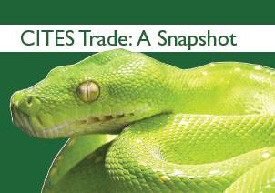International trade in wildlife contributes substantially to the livelihoods of local and indigenous communities and of the rural poor. The Convention on International Trade in Endangered Species of Wild Fauna and Flora (CITES) aims to ensure that trade remains legal, sustainable and traceable, and that no species of wild animal or plant becomes threatened in the wild as a result of such trade.
To gain better insight into the levels of international trade regulated by the Convention, the CITES Secretariat commissioned the UNEP World Conservation Monitoring Centre (UNEP-WCMC) to produce a report on trade trends of species listed in CITES Appendix II, which represent 96% of the close to 35,000 species covered by CITES.
UNEP-WCMC analysed trade trends in key commodities of Appendix II species over the period 1996-2010. This analysis included trade in wild, ranched, captive-bred and artificially propagated specimens
 The key highlights of this analysis are explained in a new brochure published by the CITES Secretariat. The brochure includes snapshots of the analyses made, and the trade value and trends of key commodities of Appendix II species. It also presents many of the trends graphically, thereby giving readers a better grasp on the extent and importance of the Convention in the conservation and sustainable use of species.
The key highlights of this analysis are explained in a new brochure published by the CITES Secretariat. The brochure includes snapshots of the analyses made, and the trade value and trends of key commodities of Appendix II species. It also presents many of the trends graphically, thereby giving readers a better grasp on the extent and importance of the Convention in the conservation and sustainable use of species.The draft report, CITES Trade: recent trends in international trade in Appendix II-listed species (1996-2010), presents the complete analysis and findings. The draft report can be found here on the CITES website.
The brochure may be downloaded in English, French and Spanish at:
The CITES Secretariat is thankful for the generous financial support received from the European Commission, which has made the publication of this brochure possible.